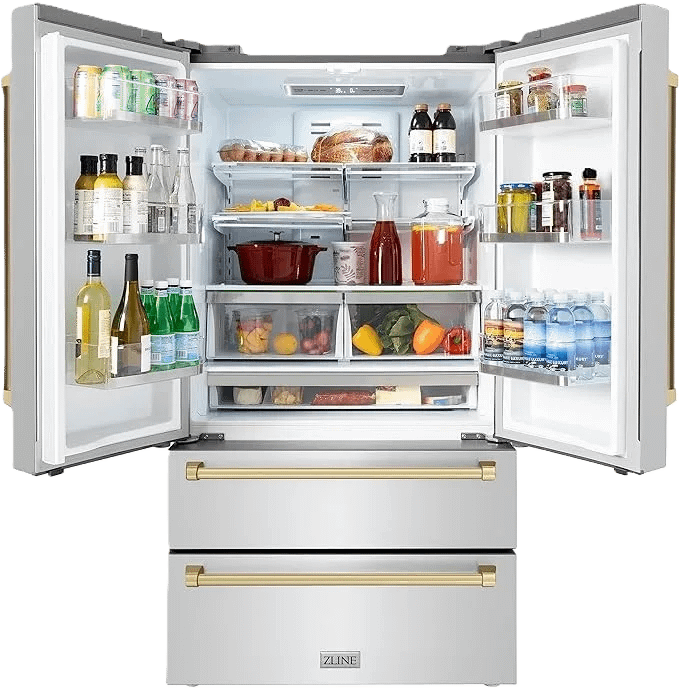Counter Depth Refrigerator – The Ultimate Buyer’s Guide
A counter depth refrigerator is designed to align flush with your kitchen counters and cabinets, typically measuring 24 to 30 inches deep. This creates a seamless, built-in look, saves crucial floor space, and enhances kitchen flow. While offering a sleek profile, a counter depth refrigerator may have slightly less interior capacity than a standard model, so planning for installation and storage needs is key.
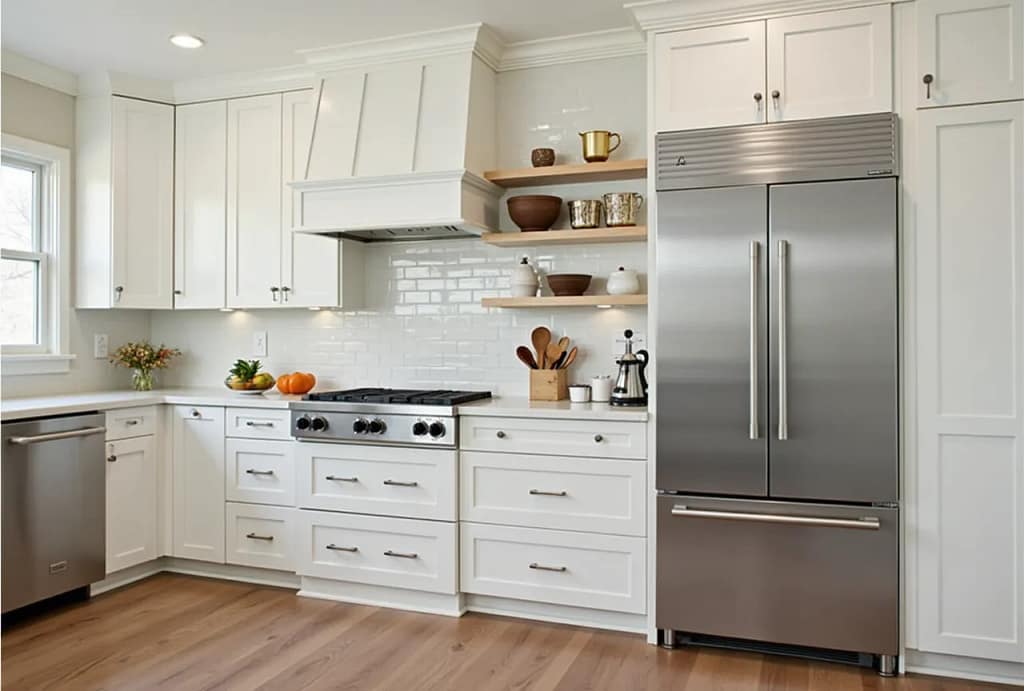
Why are counter-depth refrigerators trending in modern kitchens?
The modern kitchen is more than a place to cook; it’s the heart of the home, a space for gathering and entertaining. In this design-centric era, the bulky, protruding appliance is becoming a relic of the past. Homeowners and designers are increasingly turning to the streamlined elegance of the counter depth refrigerator to achieve a cohesive, upscale look. This guide will delve into everything you need to know about these stylish appliances, from their space-saving benefits to the practical considerations of owning one. If you value a seamless aesthetic and an uncluttered floor plan, you’re in the right place. (Source: Forbes Home)
What Is a Counter Depth Refrigerator?
Definition & Design Concept
The term “counter depth” refers to a refrigerator that is specifically designed to sit flush, or nearly flush, with your standard kitchen countertops. While standard counters are typically 24 to 25 inches deep, a counter depth fridge is built to have a door depth that aligns with this measurement. The overall cabinet depth, including doors and handles, usually falls within the 24 to 30-inch range. The primary design goal is to eliminate the obtrusive “bump-out” effect of a standard-depth refrigerator, creating a clean, built-in appearance that integrates smoothly with your cabinetry. This results in a visually smart and uncluttered kitchen line, making the entire space feel larger and more intentionally designed. (Source: Whirlpool)
Standard vs Counter Depth Refrigerator
The most fundamental decision when choosing a new refrigerator is understanding the core differences between standard and counter-depth models. The choice often comes down to a trade-off between maximum storage capacity and a streamlined aesthetic.
| Feature | Counter Depth Refrigerator | Standard Depth Refrigerator |
|---|---|---|
| Depth | 24-30 inches | 30-36 inches |
| Capacity | Generally less (e.g., 20-25 cu. ft.) | Generally more (e.g., 25-30+ cu. ft.) |
| Fit & Profile | Flush with cabinets, integrated look | Extends 6+ inches beyond counters, protruding look |
| Aesthetic | Sleek, modern, built-in | Traditional, utilitarian |
| Ideal For | Small kitchens, open floor plans, modern designs, homeowners prioritizing aesthetics | Large families, those who need maximum food storage, budget-conscious buyers |
Cons & Pros:
- Pros of a Counter Depth Refrigerator: The primary advantage is the sleek, custom look that enhances kitchen flow and visual appeal. It also saves valuable floor space in walkways, a critical benefit for small kitchens and galley-style layouts.
- Cons of a Counter Depth Refrigerator: The most significant drawback is the reduced interior capacity. To achieve the slimmer profile, manufacturers often sacrifice storage space. This can sometimes mean a higher cost per cubic foot compared to standard models.
Which type is best for your needs? Choose a counter depth refrigerator if you prioritize a modern, seamless kitchen aesthetic and are willing to trade some interior space for a less obtrusive footprint. Opt for a standard-depth model if your top priority is maximizing storage capacity for a large family and you are less concerned about the appliance protruding into the room. (Source: Consumer Reports)
Counter Depth Refrigerator Dimensions & Size Guide
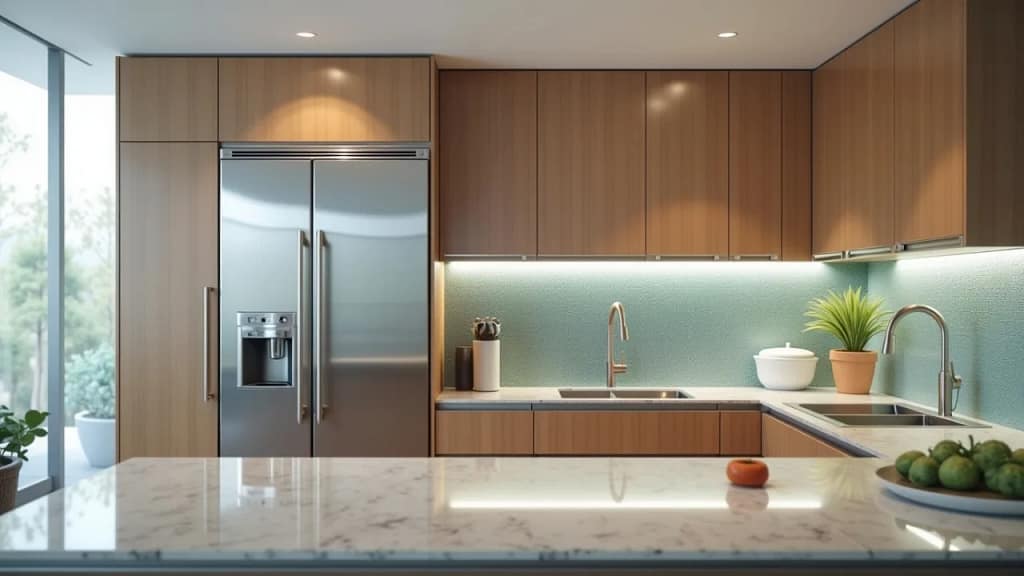
Common Dimensions
Understanding the exact counter depth refrigerator dimensions is the most critical step in the purchasing process. While the “depth” gets the most attention, you must consider all three measurements.
- Width: This is the most standardized dimension. Most full-size models are between 30 and 36 inches wide to fit standard kitchen spaces. French door models are commonly 36 inches wide.
- Height: Height is typically around 68 to 70 inches, allowing it to fit under standard upper cabinets. Built-in models may be taller.
- Depth: This is the defining measurement. The cabinet body of a counter depth refrigerator is usually about 24-25 inches deep. However, you must account for the doors and handles, which will add another 2-4 inches. Always look for the “depth with door” or “overall depth” specification, as this is what will determine if it’s truly flush.
The Importance of Clearance: A refrigerator cannot be shoved perfectly against the wall. You must account for counter depth refrigerator clearance for two vital reasons: ventilation and door swing. Most manufacturers recommend at least 1-2 inches of space at the top and back for proper air circulation, which prevents the compressor from overworking and ensures energy efficiency. (Source: GE Appliances)
Measuring Your Kitchen Space
5 Steps to Getting the Right Size:
- Measure the Space: Measure the width, height, and depth of the niche where the refrigerator will go. Measure in multiple places, as walls and floors are not always perfectly square.
- Account for Clearance: Add at least 1 inch to the back and top of your measurements for ventilation. For the sides, ensure there is enough room for the doors to open fully, especially if they are near a wall or island.
- Check Doorways and Hallways: Measure all doorways, hallways, and stairwells the refrigerator must pass through to reach its final destination. The unit may need to be tilted or have doors removed for installation.
- Consider the Door Swing: Decide if you need a left or right-opening door based on your kitchen’s layout. French door models are often preferred for tight spaces as their doors require less side clearance.
- Verify the Spec Sheet: Before purchasing, double-check the manufacturer’s specifications for the model’s exact overall dimensions, including with the door open 90 degrees.
Installation Gaps & Ventilation Tips: Never ignore the recommended clearance. Blocking ventilation can lead to premature compressor failure, higher power usage, and inconsistent cooling. If your space is extremely tight, consider models with front-venting or built-in designs that often have different ventilation requirements. (Source: The Home Depot)
Before choosing your model, it’s important to know the exact Counter Depth Refrigerator Dimensions to ensure a perfect fit for your kitchen layout. This guide explains standard sizes, measurement tips, and how to avoid installation mistakes.
Types of Counter Depth Refrigerators
French Door Counter Depth Refrigerator
This is one of the most popular styles on the market. A French door counter depth refrigerator features two narrow doors on top for the fresh food compartment and a pull-out freezer drawer on the bottom. This design provides easy access to frequently used fresh items without opening a wide door, helping to maintain cold air. The narrow doors are also ideal for kitchens with limited side clearance. They are renowned for their stylish appearance and organizational flexibility.
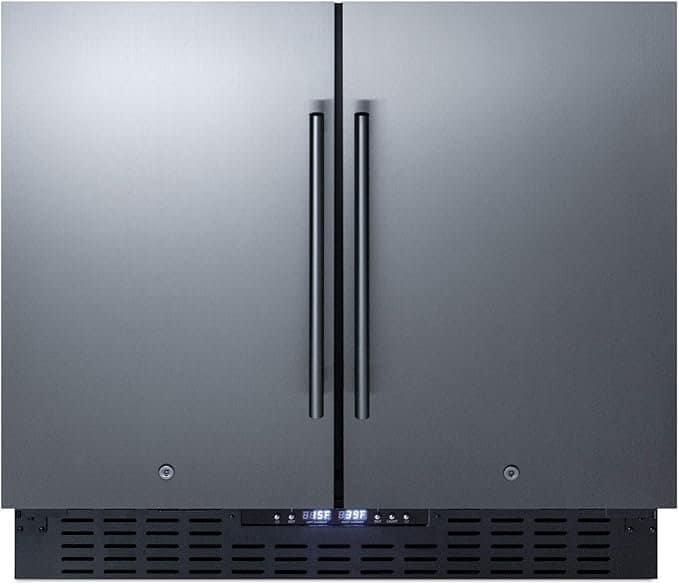
Side-by-Side Counter Depth Refrigerator
The classic side-by-side model places the freezer on one side and the refrigerator on the other. The main advantage is that both compartments are at eye level, making it easy to see everything you have. These models are often narrower, which can be a benefit in tight spaces. However, the compartments are also narrower, which can make storing wide items like pizza boxes or large sheet cakes a challenge.
Bottom Freezer Counter Depth Refrigerator
This design features a single, full-width door for the refrigerator on top and a pull-out freezer drawer below. It combines the wide, unobstructed shelving of a top-freezer model with the convenience of not having to bend down for the fresh food compartment. It’s a practical and often more affordable option than French door models.
Built-In vs Freestanding
It’s crucial to understand this distinction:
- Freestanding: These are the most common counter depth refrigerators. They are designed to stand alone and can be installed flush with cabinets. They typically have finished sides and can be moved, though they are heavy.
- Built-In: These are premium, custom units designed to be installed within a cabinet framework, often with custom panels that match your cabinetry for a completely seamless look. They are significantly more expensive and are not meant to be moved. True built-in models are different from “counter-depth” freestanding models, though the terms are sometimes used interchangeably in marketing. (Source: Bosch Home)
Energy Efficiency & Power Usage
Energy Star Ratings Explained
The ENERGY STAR label is a government-backed symbol for energy efficient appliances. An ENERGY STAR certified counter depth refrigerator uses advanced technology to consume at least 10% less energy than standard models, saving you money on your utility bills and reducing your environmental impact. When shopping, look for the blue ENERGY STAR logo to ensure you’re getting a model that meets strict efficiency guidelines set by the EPA. (Source: ENERGY STAR)
Power Consumption Comparison
While a counter depth refrigerator might have a similar compressor to a standard model, its efficiency can be influenced by its insulation and how hard it has to work based on ventilation. Modern inverter compressors, like those found in many LG and Samsung models, are generally more efficient and quieter than traditional compressors.
| Feature | Standard Model (Non-ENERGY STAR) | ENERGY STAR Counter Depth Model |
|---|---|---|
| Estimated Annual Energy Use | 600 – 800 kWh | 400 – 550 kWh |
| Estimated Annual Cost | $70 – $95 | $48 – $65 |
| Technology | Often traditional compressor | Often inverter compressor |
| Environmental Impact | Higher | Lower |
Tips to Reduce Electricity Use
- Ensure proper ventilation clearance to prevent the compressor from overworking.
- Set the temperature to the manufacturer’s recommendation (typically 37°F for the fridge, 0°F for the freezer).
- Keep the condenser coils clean by vacuuming them every 6-12 months.
- Ensure door seals (gaskets) are tight and not leaking cold air.
- Don’t leave the door open for extended periods.
Best Counter Depth Refrigerator Brands
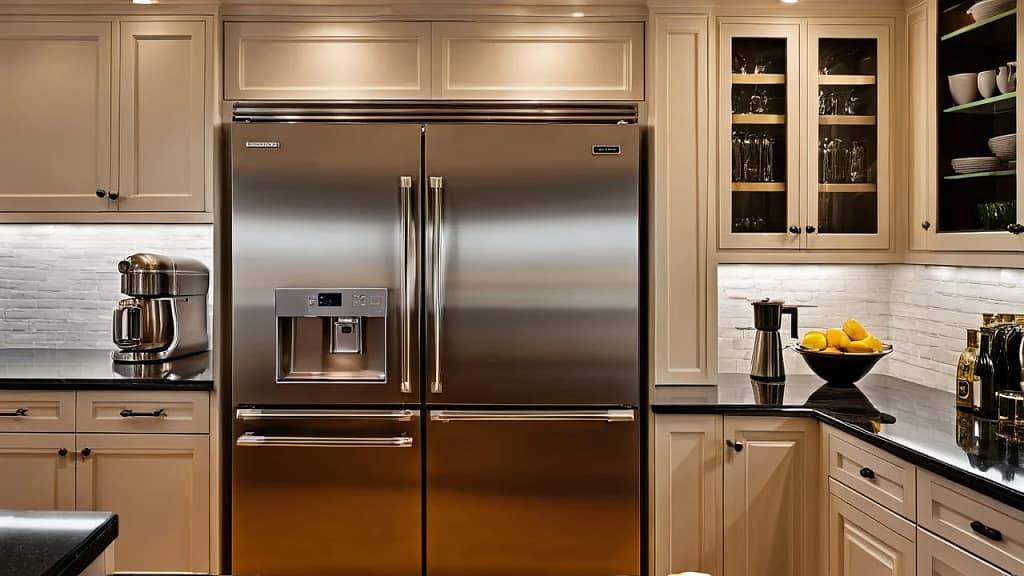
LG Counter Depth Refrigerator
LG is a leader in the refrigerator market, known for its reliable Linear Compressor, which comes with a 10-year warranty. Their counter depth refrigerator models often feature sleek designs, innovative “Door-in-Door” technology that provides quick access to frequently used items, and smart ThinQ technology that allows you to monitor and control the fridge from your phone. They are a strong contender for those seeking a blend of innovation and reliability. (Source: LG)
Samsung Counter Depth Refrigerator
Samsung pushes the envelope with technology and design. Their counter depth fridge offerings frequently include the popular Family Hub—a giant touchscreen on the door that can stream music, display calendars, and even let you see the inside of the fridge via internal cameras. They also feature flexible “FlexZone” compartments that can be switched between refrigerator and freezer temperatures. Samsung is ideal for tech-savvy households. (Source: Samsung)
GE / Whirlpool / Bosch Comparisons
- GE: General Electric (GE) offers a wide range of dependable and stylish counter depth refrigerators, often featuring their proprietary TwinChill evaporators, which use separate air systems for the fridge and freezer to prevent odor transfer. They are known for good performance and accessible pricing.
- Whirlpool: Whirlpool focuses on practicality and durability. Their models are often praised for intuitive layouts, robust storage bins, and adaptive defrost systems. They are a go-to brand for those who want a no-nonsense, reliable appliance from a trusted name.
- Bosch: Bosch is synonymous with premium German engineering, quiet operation, and sleek, minimalist design. Their counter depth refrigerator lines, especially the 800 Series, are often lauded for their outstanding build quality, efficient cooling performance, and innovative features like HomeConnect and VitaFresh temperature drawers. They compete at the higher end of the market.
Brand Comparison Table
| Brand | Key Features | Typical Warranty (Compressor) | Energy Rating | Price Range |
|---|---|---|---|---|
| LG | Linear Compressor, Door-in-Door, ThinQ | 10 years | ENERGY STAR | $$$ |
| Samsung | Family Hub, FlexZone, External Water Dispenser | 5-10 years | ENERGY STAR | $$$ |
| GE | TwinChill Evaporators, SmartHQ | 5 years | ENERGY STAR | $$ – $$$ |
| Whirlpool | Adaptive Defrost, Accu-Chill Temp Management | 5-10 years | ENERGY STAR | $$ |
| Bosch | HomeConnect, VitaFresh, QuietOperation | 5-10 years | ENERGY STAR | $$$$ |
Installation & Maintenance
Professional Installation Checklist
Hiring a professional is often the safest bet. A qualified installer will:
- Verify the electrical outlet is dedicated and properly grounded.
- Ensure the floor is level.
- Position the refrigerator in the space, accounting for all clearances.
- Connect the water line (for ice makers and water dispensers) and check for leaks.
- Level the unit and ensure doors swing correctly and can be adjusted.
- Let the refrigerator settle for several hours before plugging it in and starting the cooling cycle.
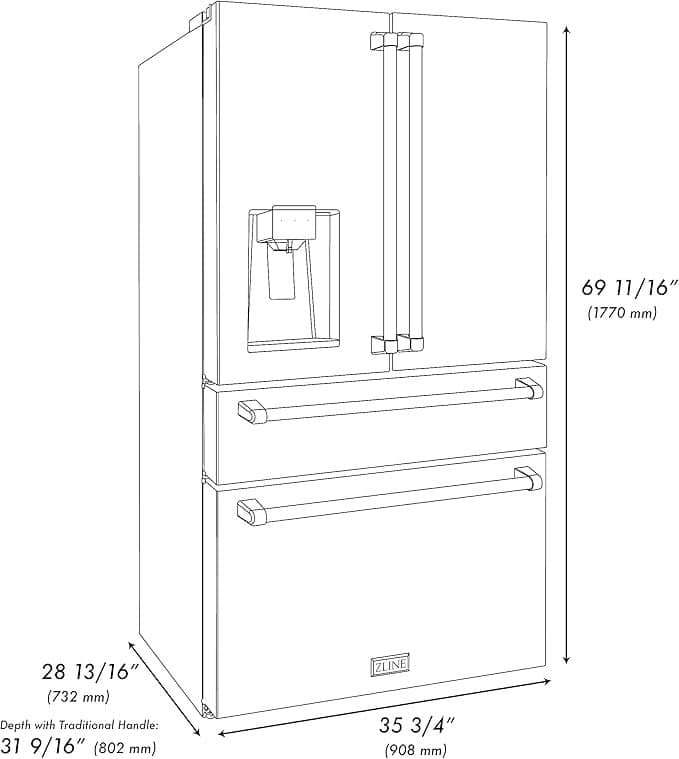
DIY Installation Guide (Step-by-step)
If you are experienced with home projects, a DIY installation is possible.
- Prepare the Space: Remove the old refrigerator and thoroughly clean the area.
- Check Water Line: If connecting to water, ensure you have a copper or braided stainless steel supply line. Turn off the water supply before connecting.
- Move the Unit: Carefully move the new refrigerator into place, using a dolly and helpers. Protect your floors.
- Level the Refrigerator: Use a wrench to adjust the front leveling legs until the unit is perfectly level side-to-side and front-to-back. This ensures proper door closure.
- Connect Water: Attach the water line to the valve on the wall and the connection port on the refrigerator. Turn the water on and check for leaks immediately.
- Power On: Plug the unit into a dedicated outlet. Set the temperature controls and allow 24 hours for the refrigerator to reach its optimal temperature before adding food.
Regular Maintenance Tips
- Cleaning Coils: Vacuum the condenser coils (usually located on the bottom or back of the unit) every 6-12 months to maintain efficiency.
- Gasket Care: Wipe down the door seals monthly with warm, soapy water to ensure a tight seal. A weak seal is a major source of energy loss.
- Interior Cleaning: Clean the interior with a baking soda and water solution every few months to prevent odors.
- Ice Maker & Water Filter: Replace the water filter as recommended by the manufacturer (usually every 6 months). Sanitize the ice maker bin periodically.
Counter Depth Refrigerator Clearance & Deals
Finding the best counter depth refrigerator deal requires timing and strategy. Major holiday sales events like Black Friday, Memorial Day, and Fourth of July are traditionally the best times to buy, as retailers like Home Depot, Lowe’s, and Best Buy offer significant discounts and bundle deals.
To find clearance discounts, visit local appliance showrooms and ask about floor models or discontinued models. These can be heavily discounted. Online, check the “Outlet” or “Clearance” sections on retailer websites.
When considering refurbished vs new models, a refurbished unit from an authorized dealer can be a great value, as it has been inspected, repaired if necessary, and typically comes with a warranty. However, for a new model with the latest features and a full manufacturer’s warranty, buying new is the safest, though more expensive, route. (Source: Best Buy)
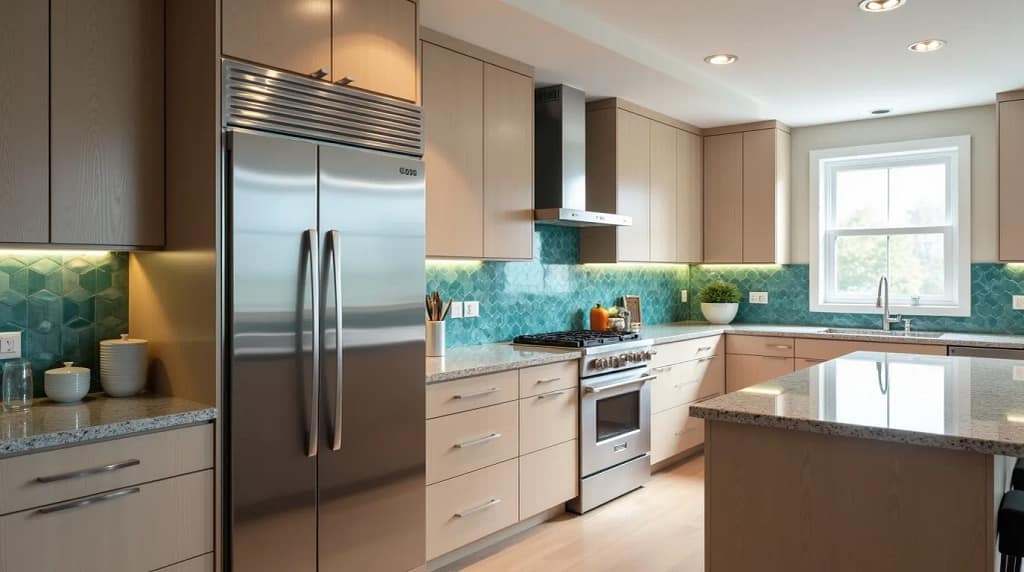
Replacement, Warranty & After-Sales
Warranty Coverage
Most counter depth refrigerators come with a warranty that is split into parts:
- Parts & Labor: Typically 1 year of comprehensive coverage for most components.
- Sealed System (Compressor, Condenser, Evaporator): Often covered for 5-10 years. This is the most critical and expensive part of the refrigerator.
Always read the warranty documentation carefully to understand what is and isn’t covered. Brands like LG and Samsung are known for their long compressor warranties.
Extended Warranty Plans
Retailers often sell extended warranty plans. Consider the cost of the plan versus the cost of a potential repair. For a complex appliance with electronic boards and a compressor, an extended warranty can provide peace of mind, especially if you plan to keep the refrigerator for a long time.
When to Replace Your Refrigerator
Consider replacing your refrigerator if:
- It is over 10-15 years old and inefficient.
- You face frequent, costly repairs.
- It no longer maintains a consistent temperature.
- It is excessively noisy or frost builds up quickly.
- You are remodeling your kitchen and want a new look and features.
Counter Depth Solutions for Small Kitchens
The counter depth refrigerator is a godsend for small kitchens, apartments, and condos. Its space-saving profile can make a tiny kitchen feel significantly larger. For very tight spaces, consider a slimmer 30-inch wide model instead of a 36-inch one. Look for models with innovative interior layouts, like fold-down shelves and tall door bins, to maximize every inch of storage. Galley kitchens and open-plan studios benefit immensely from the flush profile, which improves traffic flow and creates a less cluttered sightline. Accessories like slim under-cabinet organizers can further enhance space efficiency. (Source: Apartment Therapy)
Counter Depth Refrigerator FAQs
What is a counter depth refrigerator?
A counter depth refrigerator is designed to align flush with standard kitchen countertops (about 24-25 inches deep), creating a built-in, seamless look, unlike standard models that protrude several inches into the room.
How deep is a counter depth fridge?
The cabinet of a counter depth fridge is typically 24-25 inches deep, but with the door and handles, the overall depth usually ranges from 27 to 30 inches.
Are counter depth refrigerators more expensive?
Generally, yes. They often cost more than comparable standard-depth models due to the specialized design and engineering required to maximize space in a slimmer profile.
Which brand makes the most reliable counter depth refrigerator?
Reliability varies by model and year. However, brands like Bosch, LG, and Whirlpool consistently receive high marks for reliability and customer satisfaction in independent surveys from sources like Consumer Reports.
Can I install a counter depth refrigerator myself?
Yes, if you are comfortable with basic home tasks like moving heavy objects, leveling, and potentially connecting a water line. However, professional installation is recommended to ensure proper setup, ventilation, and to avoid damaging the appliance.
Comparison Table
| Feature | Counter Depth Refrigerator | Standard Depth Refrigerator |
|---|---|---|
| Depth | 24–30 inches | 30–36 inches |
| Capacity | Less (e.g., 20-25 cu. ft.) | More (e.g., 25-30+ cu. ft.) |
| Fit | Flush with cabinets | Extends out beyond counters |
| Look | Sleek, built-in, modern | Traditional, protruding |
| Ideal For | Small kitchens, modern designs, open floor plans | Large families, maximum storage needs |
Customer Reviews & Real Experiences
What Buyers Love ❤️
Overwhelmingly, buyers rave about the transformative aesthetic. The most common praise is for the “built-in look without the built-in price.” Owners of small kitchens frequently mention how much more open and spacious their room feels. The sleek, flush appearance is consistently cited as the primary reason for their satisfaction.
Common Complaints ⚠️
The most frequent complaint revolves around the smaller storage capacity. Some users find the trade-off for the sleek profile to be significant, especially when trying to store large items like party platters or bulk grocery hauls. A few also note that the shallower shelves can make organizing certain items slightly more challenging.
Conclusion + CTA
The counter depth refrigerator is a brilliant solution for the modern homeowner, seamlessly blending sophisticated design with practical space-saving benefits. While it requires a thoughtful consideration of storage needs and a careful measurement of your kitchen space, the payoff is a clean, integrated, and high-end look that can elevate your entire kitchen. By understanding the dimensions, types, and features available, you can confidently choose a model that fits both your space and your lifestyle.
Compare the Best Counter Depth Refrigerators for Your Kitchen Today!
